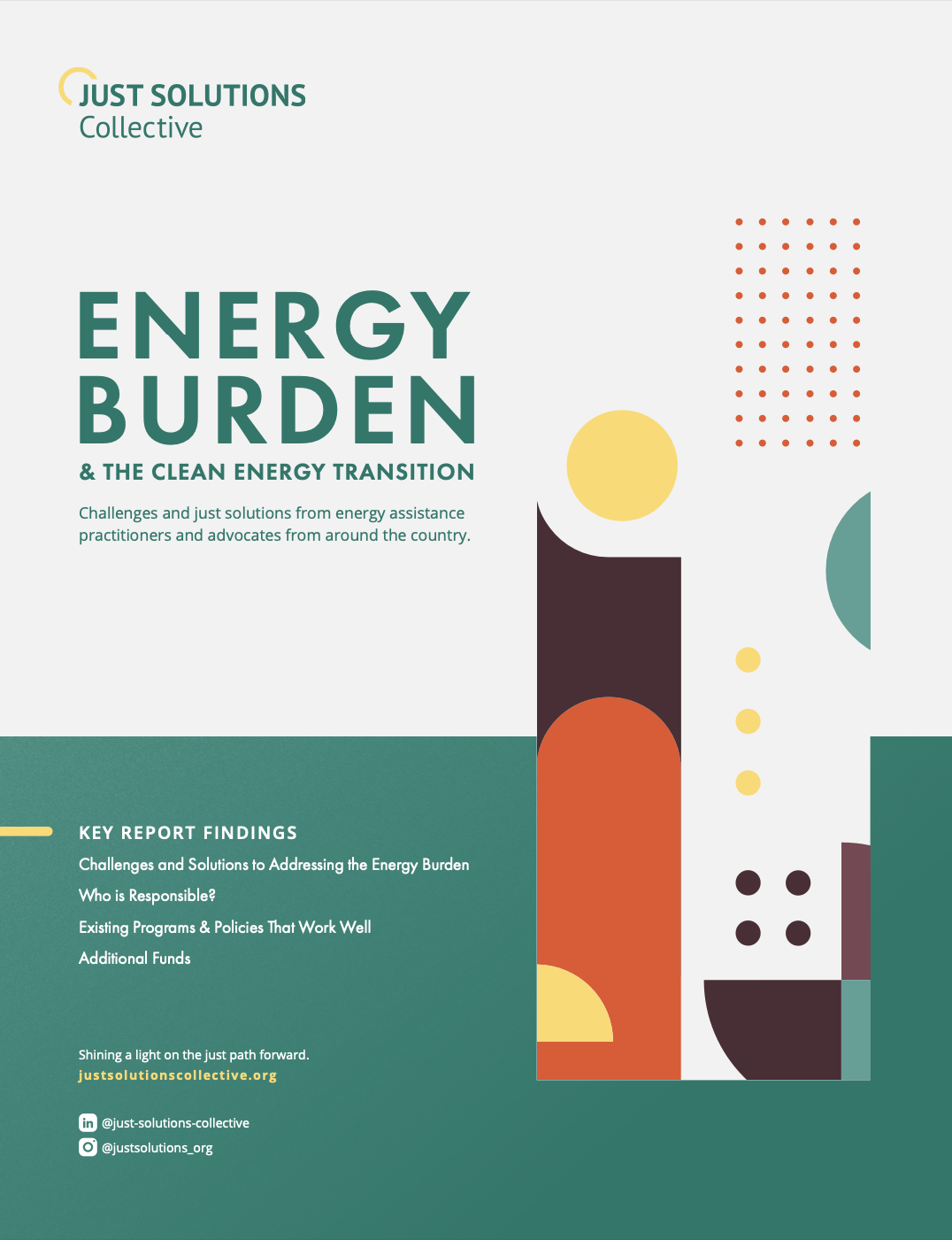This report that shines a light on energy burden reduction as an important part of the clean energy transition. This report examines fundamental inequities of our current energy landscape and the opportunities to address the issue while our nation considers changes to the power sector.
Primary Author: Zully Juarez, Senior Research and Policy Analyst
Without explicit action, low-and moderate-income (LMI)1 households, specifically low-income households2, are likely to face increased energy burdens during the transition to a clean energy system. With adequate analysis and targeted programs and policies for LMI households, the energy transition is an opportunity to invest in reducing energy burdens systematically3.
For these reasons, the Just Solutions Collective reached out to experts who work in low-income and frontline communities4 across the country and asked their input on how to best address the energy burden to ensure the transition is equitable and just. Experts provided a wealth of important insight, expertise, recommendations, and perspectives on the opportunities and challenges with addressing the energy burden and accessing energy assistance. This report’s primary purpose is to inform environmental and climate justice policy advocates, but can also be used by policymakers, utilities, energy practitioners, along with an inclusive public participation process, when making decisions about a clean energy future that centers communities most impacted by the fossil fuel industry and profit-driven IOUs.
Key Research Findings
There were five key challenges to addressing energy burden as identified by experts in the field: a.) the lack of upfront costs for LMI households to transition into energy efficiency and the lack of funding for programs; b.) shortcomings of program designs that do not properly address the energy burden or LMI household’s short-term and long-term needs; c.) administrative barriers faced by people who apply for energy assistance programs; d.) barriers faced by renters when participating in energy efficiency programs; and e.) limitations of our present-day utility models creating barriers to an equitable clean energy transition. According to the interviewees, these challenges need to be addressed to ensure a transition to renewable energy will not increase the energy burden for LMI households.
Policy recommendations
With adequate analysis and targeted programs and policies for LMI households, the energy transition is an opportunity to invest in reducing energy burdens systematically. Addressing and ultimately eradicating the energy burden is a shared responsibility amongst state agencies and multiple stakeholders.
Solutions and recommendations to address energy burden during the transition to clean energy include increasing funding and program investments for LMI households, improving program and policy design that explicitly address energy burden, increasing program participation, creating more efficient buildings and support for renters, and improving utility rates and targeting of programs. Three ways to achieve some of these goals include:
- The adoption of community-owned energy and community solar policies. If designed right, the benefits of community solar can be accessible to LMI households. This includes strong policies with requirements placed on the utility companies to interconnect those systems to the grid without exorbitant cost or administrative burdens placed on community-based organizations, nonprofit or cooperative solar developers.
- More Collaboration with Community-Based Organizations, Community Action Program (CAP) Agencies, and Faith-Based Organizations. Utilities and programs should work with community-based organizations (CBO’s), Community Action Program (CAP) Agencies, and faith-based organizations to conduct outreach, communication, and help increase participation rates by assisting with applications. These collaborations need to be funded partnerships to help CBO’s have more capacity to get more people signed up for assistance, as well as work closely with households to address language barriers and the digital divide.
- Making buildings more efficient so that they use less energy to bring down costs and address the energy burden. Building codes can be effective to enforce compliance with more energy-efficient building standards. For rental units, there is a need for enhancement of building codes, standards, and public investment in bill affordability and energy efficiency for all households of lower incomes. More advocacy and programs need to prioritize investments in people’s homes by addressing poor housing conditions and the legacies of environmental hazards and energy inefficiencies. Programs and policies must ensure landlords do not shift the cost of clean energy systems to tenants.
Conclusion
It is evident that without explicit action, low- and moderate-income (LMI) households are likely to face increased energy burdens during the transition to a clean energy system. Although states and regions differ in their administration of energy assistance programs, depending on program funding and political prioritization, there are common national challenges and barriers in addressing the energy burden, as identified by experts in the field. According to the interviewees, these solutions and recommendations will help the effectiveness of policies and energy assistance programs as we transition to clean energy.
***
Just Solutions Collective hosted a webinar presentation on March 31, 2022 sharing key findings from the report and a panel from practitioners and experts in the field. You can find the recording of the webinar at this link. The password is 6C5=Nd0D.
References:
2. Note: When referring to LMI, it is important to note that there is diversity in financial circumstances and security within the LMI construct.
